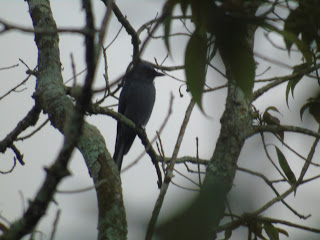The final report of DIKTI PKM which has drained the energy, mind, and time for two days is complete and ready to be collected. Refreshing alias refreshing brain needs to be done after tired with the business of calculating taxes and editing posts. Bird watching is the choice. Cold Plawangan and its contents become opium to always visit it.
Saturday, July 11, 2015 I left for Tlogo Nirmolo with Rahmadiyono. Arriving at the location, we met Mas Panji with two tourists from local and long distance. Had a brief chat, we parted because the path we chose was different. We chose the path to Tlogo Princess while they chose the Japanese Cave line.
The clock shows the time 07:30 wib, we took out cameras, binoculars, and notebooks. Observations begin. Just a few steps, we were greeted by a Javan Whistling Trush / Ciung-stone Java is walking on the observation track. Had run away but not far away. When I try to take a picture, the camera settings I have set are changed so I need to set them again. Birds are blurred.
The Campephagidae family is represented by the Sunda Minivet / Sepah gunung which amounts to 3 individuals. At the end of the observation we also encountered Female Scarlet Minivet / Sepah female forest which amounted to two tails. Had made curious because I only glimpsed the long tail of the yellow color and did not get immortalized in the camera lens.
One of the birds that I managed to document well was Ashy Drongo / Srigunting kelabu though it took a few shots and moments to wait for him to sit quietly on a tree limb. However, a typical tail-shaped scissor that this bird has covered tree branches.
The path to Tlogo Princess is very quiet. We decided to turn back. The right decision might be because shortly afterwards two Chestnut-backed Scimitar Babbler appeared. They are disturbed by the activity of three squirrels who are fighting over food.
Indigo Flycatcher blue is also included in the list. This bird was invisible closed shadow trees. Thanks to his distinctive voice, we managed to find him.
On the way down the stairs, a pair of Ciu Jawa (formerly named Great Ciu) / Pied Shrike-babbler was observed. Keep in mind, for a budding observer if you want to match this bird with a picture in MacKinnon's manual will be quite difficult. This is because the picture in the MacKinnon book is quite different from the fact Ciu Jawa in the field.
Other common birds are also recorded as Sooty-headed Bulbul, Cave Swiftlet, and Oriental White-eye. Pink-headed Fruit Dove's pink-headed whistle that we can only find despite being far enough in the top of the trees.
Many things I encountered but not all can be documented. At least I can still be grateful to have the documentation tool provided by the Creator in the form of eyes and brain.

No comments:
Post a Comment
Terima kasih sudah berkunjung.
Tinggalkan komentar Anda dan kami akan mengunjungi halaman Anda.